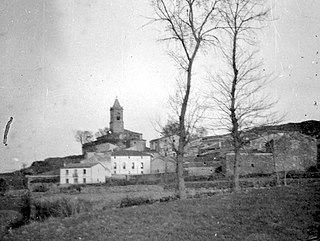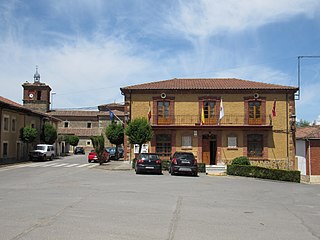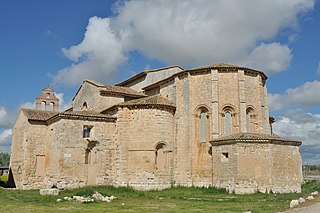
Hubley Township is a township in Schuylkill County, Pennsylvania, United States. The population was 854 at the 2010 census, a drop of less than 1% from the previous census in 2000.

In the Christian tradition, a nativity scene is the special exhibition, particularly during the Christmas season, of art objects representing the birth of Jesus. While the term "nativity scene" may be used of any representation of the very common subject of the Nativity of Jesus in art, it has a more specialized sense referring to seasonal displays, either using model figures in a setting or reenactments called "living nativity scenes" in which real humans and animals participate. Nativity scenes exhibit figures representing the infant Jesus, his mother, Mary, and her husband, Joseph.

Etayo is a town and municipality located in the province and autonomous community of Navarre, northern Spain.

Beaumont Provincial Park is a provincial park located at the southeast end of Fraser Lake, between Fort Fraser and the town of Fraser Lake, British Columbia, approximately 40 km west of Vanderhoof, British Columbia. The park contains the site of the original Fort Fraser.

Buse Lake Protected Area, informally known as Buse Lake Provincial Park is a provincial park in British Columbia, Canada, 23 km ESE of Kamloops near Monte Creek. It was created in 2000 as part of the outcome of the Kamloops Landuse and Resource Management Plan (KLRMP) and is 228 hectares in size.
Stuart River Provincial Park is a provincial park in British Columbia, Canada. It is located in two sections north and northwest of Vanderhoofalong the Stuart River southeast of Stuart Lake and the city of Fort St. James. The upper section is located at 54°13′20″N124°00′00″W and comprises c.7391 ha. while the lower, eastern section is centred at 54°03′00″N123°37′00″W and comprises c.3390 ha. and is within the Greater Prince George area. The upper site, which is located around the confluence of the Stuart and Nechako Rivers, includes the site of Chinlac, a Dakelh village whose inhabitants were massacred and enslaved by the Tsilhqot'in of Anahim Lake c. 1745.
Todagin South Slope Provincial Park is a provincial park in British Columbia, Canada, located on the west side of Todagin Creek to the east of Kinaskan Lake in the Stikine Country, to the south of the community of Dease Lake. Created in 2001, it contains c. 3557 ha.
Hamilton is an unincorporated community and a U.S. Post Office in Moffat County, Colorado, United States. The Hamilton Post Office has the ZIP Code 81638.

The Canoe Creek Band/Dog Creek Indian Band, also known as the Canoe Creek First Nation and/or Dog Creek First Nation is a First Nations government of the Secwepemc (Shuswap) Nation, located in the Fraser Canyon-Cariboo region of the Central Interior of the Canadian province of British Columbia. It was created when the government of the then-Colony of British Columbia established an Indian Reserve system in the 1860s. It is a member government of the Northern Shuswap Tribal Council.

The Cave Without a Name is a limestone solutional cave in the Texas Hill Country region of central Texas. It is a National Natural Landmark.

Murrayville is a small community in the Township of Langley in the Lower Mainland region of British Columbia, Canada.

Vegas del Condado, Vegas del Condáu, in Leonese language, is a municipality located in the province of León, Castile and León, Spain. According to the 2004 census (INE), the municipality has a population of 1,361 inhabitants.

Corcos is a municipality located in the province of Valladolid, Castile and León, Spain. According to the 2004 census (INE), the municipality has a population of 258 inhabitants.

PHotoEspaña, the International Festival of Photography and Visual Arts of Madrid, is a photography forum that began in 1998. The Festival’s program presents work by Spanish and international image-makers. It runs an awards programme with several categories.
Roda is a village near Mangualde in the district of Viseu, Portugal. It is located at 40°37′00″N07°47′00″W and has an altitude of 497 m (1633 ft).

Isahakyan, known as Kharum until the 1820s, and later as Ghazarabad until 1945, is a village in the Shirak Province of Armenia. It was formerly named after Ghazar Agha who organized the defense of the town against the Persians in 1826–1828; later named after poet Avetik Isahakyan, who lived there.

The Eastern Region is one of the 10 administrative regions in which Venezuela was divided for its development plans; it comprises the states of Anzoátegui, Monagas, and Sucre.
Quebrada de Piedra is a corregimiento in Tolé District, Chiriquí Province, Panama. It has a land area of 98.3 square kilometres (38.0 sq mi) and had a population of 1,127 as of 2010, giving it a population density of 11.5 inhabitants per square kilometre (30/sq mi). Its population as of 1990 was 1,197; its population as of 2000 was 1,209.
Bahía Honda is a corregimiento in Macaracas District, Los Santos Province, Panama with a population of 646 as of 2010. Its population as of 1990 was 648; its population as of 2000 was 616.

Paraíso is a corregimiento in Pocrí District, Los Santos Province, Panama with a population of 597 as of 2010. Its population as of 1990 was 574; its population as of 2000 was 593.
















